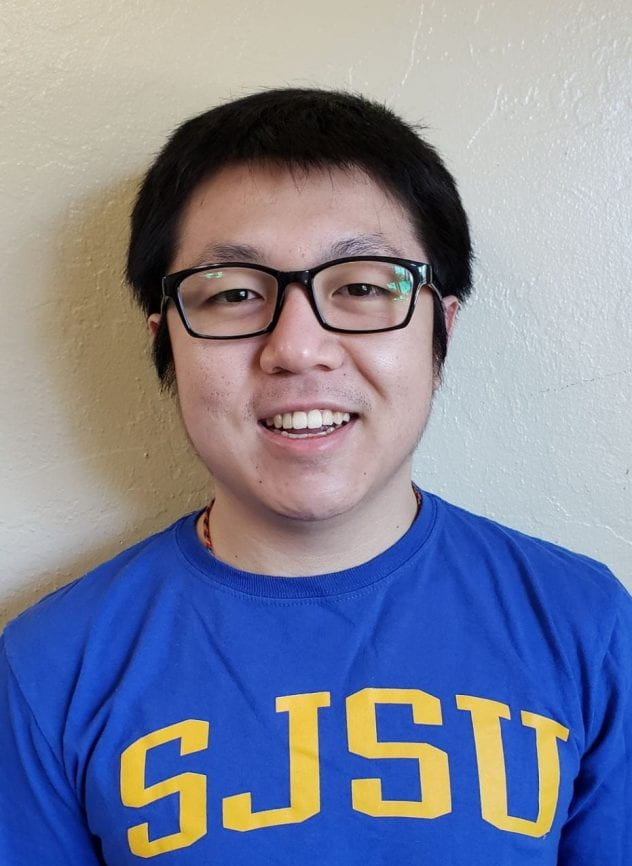What makes diamonds so valuable? Most of us would point to their brilliance, clarity and beauty. But Christopher Smallwood, assistant professor of physics and astronomy at San José State, has a different answer: He looks to diamonds as the key to unearthing the secrets of quantum physics.

Smallwood and his collaborators are examining silicon-vacancy centers, which are a type of atom-sized flaw, in diamonds in order to better understand quantum physics. Illustration by Pourya Nadimi
Smallwood and his collaborators are using diamonds to better understand how the world works at the scale of a single atom. His recent findings, “Hidden Silicon-Vacancy Centers in Diamonds,” were published in May in the journal Physical Review Letters.
In the jewelry store, people typically look for the diamond with the fewest flaws. But Smallwood explained that, in the lab, these flaws are exactly what can make diamond samples so special.
He and fellow researchers create atom-sized flaws in the diamonds. Then, using a laser with pulses of light less than a trillionth of a second, they can observe the details and properties of those flaws “in a way we never had been able to before,” Smallwood said.
Exploring new territory

Christopher Smallwood, assistant professor of physics and astronomy
Why diamonds? To start, their crystal clear makeup allows scientists to easily access flaws with laser technology, Smallwood explained.
But what’s more, they contain a treasure trove of quantum secrets for physicists to uncover.
“There are literally books about optical resonances in diamonds for which no one understands the underlying origin,” he said. By resonances, he means physical responses in the diamonds to outside stimuli, such as light.
“From an experimental physicist’s point of view, it’s really great to have so much left to explore.”
Smallwood noted that his research takes place amid Silicon Valley’s push toward quantum engineering — that is, applying quantum physics to technology. Currently, IBM and Google, for example, are building quantum computers, which will have the power to apply quantum physics knowledge to solve today’s most pressing issues, like creating sustainable energy, reducing emissions and developing more helpful artificial intelligence.
Smallwood’s research demonstrates how San José State could become a key player in this process.
“I’ve seen a number of companies pop up in and around Silicon Valley in recent years aiming to make new inroads in quantum technology, and SJSU is well-positioned to help train the workforce required to make these technological dreams a reality,” Smallwood explained. “The publication of this paper helps underscore this potential.”
Shining light at San José State
Smallwood’s recent findings tie closely with his project funded by a grant from the National Science Foundation he received in 2020. The grant has allowed Smallwood to advance San José State’s capabilities of studying the properties of diamonds and other materials through light.
“SJSU is great because of the ways it allows me to directly work with undergraduate and master’s students and stay active in the laboratory,” he said. “Student participation in these research efforts is crucial. And I’ve got some extraordinary graduate and undergraduate students currently working in my group.”
One of those students is Tommy Wen Chin, ’22 Physics, who is helping Smallwood to better understand the recent findings. Together, he and Smallwood will work on another manuscript that explores the theory behind the work, which they will submit for publication.

Tommy Wen Chin, ’22 Physics
Chin said he’s gaining valuable experience for the future: He plans to pursue a PhD in physics and a career in academic research.
“This experience will give me a significant head start in that process, as I learn not only to perform research, but also to formally report it through publications. Being a first author on a publication as an undergraduate student is very rare within academic circles, and this will enhance my credibility as I apply for programs.”
But most importantly, Chin said he is getting to explore his passion and advance his knowledge of quantum physics.
“The opportunity to learn something new in physics is what drives me,” he shared. “The process of research projects often involves learning bits and pieces of the physics here and there. The most interesting and exciting part for me is when all these little pieces fit together seamlessly and tell a cohesive story.”
Smallwood, of course, understands Chin’s passion for quantum physics and the research process as a whole.
“There’s something really aesthetically beautiful about the theoretical side of the work, and on the experimental side, you get to build things with your own hands,” Smallwood said. “I enjoy working with lasers and shining light on things because — even at the level of high-level physics experiments — seeing is believing.”
View Smallwood’s published study in the Physical Review Letters journal.
